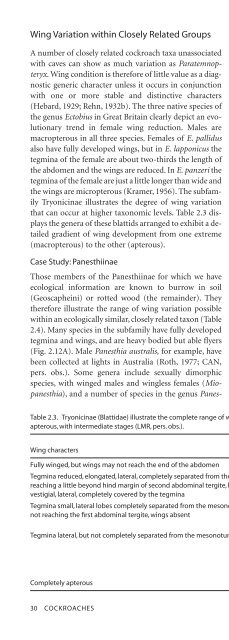Cockroache; Ecology, behavior & history - W.J. Bell
Cockroache; Ecology, behavior & history - W.J. Bell
Cockroache; Ecology, behavior & history - W.J. Bell
You also want an ePaper? Increase the reach of your titles
YUMPU automatically turns print PDFs into web optimized ePapers that Google loves.
Wing Variation within Closely Related Groups<br />
A number of closely related cockroach taxa unassociated<br />
with caves can show as much variation as Paratemnopteryx.<br />
Wing condition is therefore of little value as a diagnostic<br />
generic character unless it occurs in conjunction<br />
with one or more stable and distinctive characters<br />
(Hebard, 1929; Rehn, 1932b). The three native species of<br />
the genus Ectobius in Great Britain clearly depict an evolutionary<br />
trend in female wing reduction. Males are<br />
macropterous in all three species. Females of E. pallidus<br />
also have fully developed wings, but in E. lapponicus the<br />
tegmina of the female are about two-thirds the length of<br />
the abdomen and the wings are reduced. In E. panzeri the<br />
tegmina of the female are just a little longer than wide and<br />
the wings are micropterous (Kramer, 1956). The subfamily<br />
Tryonicinae illustrates the degree of wing variation<br />
that can occur at higher taxonomic levels. Table 2.3 displays<br />
the genera of these blattids arranged to exhibit a detailed<br />
gradient of wing development from one extreme<br />
(macropterous) to the other (apterous).<br />
Case Study: Panesthiinae<br />
Those members of the Panesthiinae for which we have<br />
ecological information are known to burrow in soil<br />
(Geoscapheini) or rotted wood (the remainder). They<br />
therefore illustrate the range of wing variation possible<br />
within an ecologically similar, closely related taxon (Table<br />
2.4). Many species in the subfamily have fully developed<br />
tegmina and wings, and are heavy bodied but able flyers<br />
(Fig. 2.12A). Male Panesthia australis, for example, have<br />
been collected at lights in Australia (Roth, 1977; CAN,<br />
pers. obs.). Some genera include sexually dimorphic<br />
species, with winged males and wingless females (Miopanesthia),<br />
and a number of species in the genus Panes-<br />
Fig. 2.12 Wing condition in wood-feeding Panesthiinae. (A)<br />
Fully winged adult of Australian Panesthia australis; photo by<br />
C.A. Nalepa; (B) detail of adult Australian Panesthia cribrata<br />
showing ragged wing bases after dealation; photo courtesy<br />
of Douglas Rugg; (C) strikingly patterned winged female of<br />
Caeparia donskoffi from Vietnam, body length approximately<br />
3.5 cm; photo by L.M. Roth.<br />
Table 2.3. Tryonicinae (Blattidae) illustrate the complete range of wing development, from fully developed wings to completely<br />
apterous, with intermediate stages (LMR, pers. obs.).<br />
Genus<br />
Wing characters (no. species) Country<br />
Fully winged, but wings may not reach the end of the abdomen Methana (10) Australia<br />
Tegmina reduced, elongated, lateral, completely separated from the mesonotum, Tryonicus (3) Australia<br />
reaching a little beyond hind margin of second abdominal tergite, hindwings present, (female apterous)<br />
vestigial, lateral, completely covered by the tegmina<br />
Tegmina small, lateral lobes completely separated from the mesonotum, Punctulonicus (2) New Caledonia<br />
not reaching the first abdominal tergite, wings absent Angustonicus (2)<br />
Rothisilpha (2)<br />
Tegmina lateral, but not completely separated from the mesonotum, wings absent Pellucidonicus (2) New Caledonia<br />
Pallidionicus (5)<br />
Angustonicus (1)<br />
Punctulonicus (1)<br />
Rothisilpha (1)<br />
Completely apterous Lauraesilpha (4) New Caledonia<br />
30 COCKROACHES


